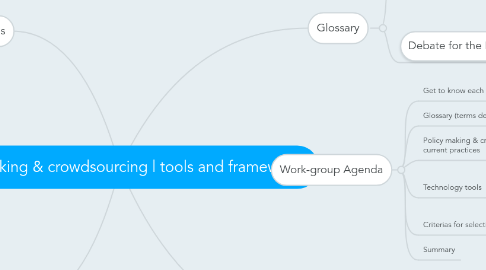
1. Available Technology tools
1.1. Online platforms/applications
1.1.1. Email
1.1.2. Forums
1.1.3. Crowdsource ideas
1.1.3.1. Aha.io
1.1.3.2. Uservoice
1.1.4. MindMaps
1.1.5. Social Websites
1.1.5.1. Facebook groups
1.1.5.2. Twitter hashtags
1.1.5.3. Elgg (social networking engine)
1.1.6. Polls
1.1.6.1. Polls everywhere
1.1.6.2. CMS Plugins
1.1.6.3. Discource
1.1.6.4. Google questionaires
1.1.6.5. Survey monkey
1.1.7. Rasing awerness tools
1.1.7.1. Avaaz
1.1.7.2. thunderclap
1.2. Advanced tools for crowdsourcing
1.2.1. Annotation Tools
1.2.1.1. Hypothesis
1.2.1.2. other
1.2.2. Crawlers
1.2.2.1. argument mining
1.2.2.2. opinion collection
1.2.2.3. hashtags
1.2.2.4. social posts
1.2.3. Natural language processing algorithms
1.2.3.1. Clustering of comments
1.2.3.2. Visualizations
1.2.3.2.1. word clouds
1.2.3.2.2. graphs
1.2.3.3. Sentiment analysis
1.2.4. Gamification
1.2.4.1. points
1.2.4.2. badges
1.2.4.3. reputation levels
1.2.4.4. progress bars
1.2.4.5. learboards
1.2.4.6. making the process feel like a game
1.2.5. Custom tools
1.2.5.1. Democracit
2. Criteria for selecting crowdsourcing tools
2.1. The policy making process
2.1.1. issue identification
2.1.2. for policy formulation
2.1.3. for decision making
2.1.4. implementation/evaluation
2.2. target group
2.2.1. Local/ National / EU level?
2.2.2. age group
2.3. accessibility of the tool
2.3.1. languages
2.3.2. compliant to people with special needs (like blind)
2.3.3. inclusiveness of minorities
2.4. How user friendly the tool is
2.4.1. is it fast?
2.4.2. is it easy to understand?
2.5. the civic engagement dimension
2.6. Time
2.6.1. Do i have a strict time schedule?
2.6.2. How much time do i need to gather the results from the citizens?
2.6.3. How much time do i need to analyze the results?
2.7. Cost
2.7.1. What is the cost of these tools?
2.7.2. What is the cost to analyze the results?
3. Work-group Agenda
3.1. Get to know each other
3.2. Glossary (terms definition)
3.3. Policy making & crowdsourcing | Overview of current practices
3.4. Technology tools
3.4.1. Online platforms
3.4.2. Technology tools - Frameworks
3.5. Criterias for selecting crowdsourcing tools
3.6. Summary
4. Glossary
4.1. Crowdsourcing
4.1.1. Definition
4.1.1.1. When work comes from an undefined public
4.1.1.2. Outsourcing work (services or ideas)
4.1.1.3. Advantages
4.1.1.3.1. impoved costs
4.1.1.3.2. speed
4.1.1.3.3. quality
4.1.1.3.4. scalability
4.1.1.3.5. diversity
4.1.1.4. Motivations
4.1.1.4.1. Intrinsic
4.1.1.4.2. Extrinsic
4.1.1.5. Disadvantages
4.1.1.5.1. management costs
4.1.1.5.2. product quality may be affected
4.1.2. Examples
4.1.2.1. Amazon Mechanical Turk
4.1.2.2. Wikipedia
4.1.2.3. Spotify
4.1.2.4. Crowdfunding
4.1.2.5. Be my eyes
4.2. Debate for the Future of Europe
4.2.1. Examples
4.2.1.1. Brainstorm
4.2.1.1.1. Financial dependency
4.2.1.1.2. Political collaboration
4.2.1.1.3. Increased border control regulation
4.2.1.1.4. Rising populism/skepticism
4.2.1.1.5. Danger of eu falling apart
4.2.1.1.6. Should Europe be that centralized?
4.2.1.1.7. EU identity and citizenship
4.2.1.1.8. Changing demography / aging population
4.2.1.1.9. Youth Unemployment
4.2.1.2. European Commission
4.2.1.2.1. Migration
4.2.1.2.2. Economic and Monetary Union
4.2.1.3. Other organizations
4.2.1.3.1. Debatingeurope.eu
4.2.1.3.2. European citizen action service
5. Policy making
5.1. The process
5.1.1. Issue identification
5.1.2. Policy formulation
5.1.3. Decision making
5.1.4. Implementation/Evaluation
5.2. Civic engagement
5.2.1. Knowledge of public affairs
5.2.2. Trust for the political system
5.2.3. Participation in influencing the law-maker and the decision-making process
5.3. Existing tools currently in use
5.3.1. for: Issue Identification
5.3.1.1. Blogging like tools
5.3.1.2. "Post your story"
5.3.1.3. Discussion forums
5.3.2. for: Policy formulation
5.3.2.1. Structured questionnaires
5.3.2.2. Budget allocation tools
5.3.2.3. Voting on ideas
5.3.3. for: Decision making
5.3.3.1. emails
5.3.3.2. forum like tools
5.3.3.3. specific forms with general remarks
5.4. Problems and issues with existing tools
5.4.1. Security
5.4.2. Verification
5.4.3. Communication between participants is bad
5.4.3.1. Tools do not allow discussion
5.4.4. Lack of political willingness to make these tools work
5.4.5. Lack of impact measurement metrics
5.4.6. Users don't get informed about how your contribution had an impact
5.4.7. Most of the tools are not institutionalized
5.4.8. Lack of participation incentives
5.4.9. Complexity with policy making
5.4.9.1. too large textual input
5.4.9.2. too complex to participate
5.4.9.3. you don't understand how it can affect your life
5.4.10. Lack of educational activities that raise awareness around the mentioned topics
5.4.11. Lack of user based design
5.4.11.1. more people should be involved in the designing of these tools
5.4.11.2. adaptive tools
5.4.12. Diversity of people is not taken into account
5.4.13. Lack of vision / direction were agenda setting processes can be based upon
